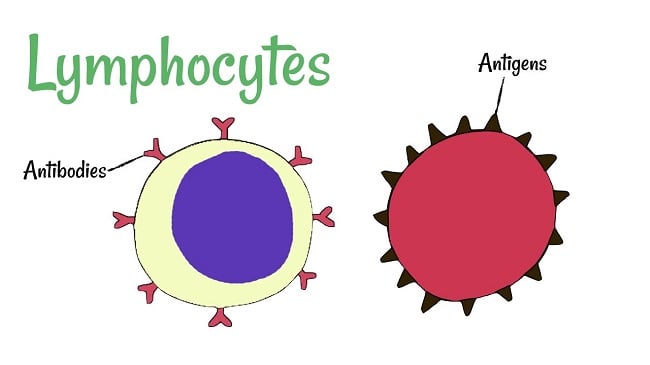Lymphocytes are the cells that specifically recognize and respond to foreign antigens and are mediators of humoral and cellular immunity. Lymphocytes, the unique cells of adaptive immunity, are the only cells in the body that express clonally distributed antigen receptors, each specific for a different antigenic determinant. Each clone of T and B lymphocytes expresses antigen receptors with a single specificity, which is different from the specificities of the receptors in all other clones. Thus, the antigen receptors of these lymphocytes are clonally distributed. Genes encoding the antigen receptors of lymphocytes are formed by recombination of DNA segments during the maturation of these cells.

Lymphocytes are the principal cell in the adaptive immune response. They represent 20% to 40% of circulating white blood cells and 99% of cells in the lymph. The total number of lymphocytes in a healthy adult is about 5 × 1011. Of these, about 2% are in the blood, 4% in the skin, 10% in the bone marrow, 15% in the mucosal lymphoid tissues of the gastrointestinal and respiratory tracts, and 65% in lymphoid organs (mainly the spleen and lymph nodes).
Interesting Science Videos
Types/ Subsets of Lymphocytes
Lymphocytes consist of distinct subsets that are different in their functions and protein products. Lymphocytes can be broadly subdivided into three major populations on the basis of functional and phenotypic differences: B lymphocytes (B cells), T lymphocytes (T cells), and natural killer (NK) cells. In humans, approximately a trillion (1012) lymphocytes circulate continuously through the blood and lymph and migrate into the tissue spaces and lymphoid organs.
Morphologically, all lymphocytes are similar, and their appearance does not reflect their heterogeneity or their diverse functions. B lymphocytes, the cells that produce antibodies, arise and maturation occur in the bone marrow. Thus, B lymphocytes now refer to bone marrow–derived lymphocytes. T lymphocytes, the mediators of cellular immunity, arise in the bone marrow, and migrate to and mature in the thymus; T lymphocytes refer to thymus-derived lymphocytes.
Subsets of B and T lymphocytes
They exist with distinct phenotypic and functional characteristics. The major subsets of B cells are follicular B cells, marginal zone B cells, and B-1 cells, each of which is found in distinct anatomic locations within lymphoid tissues. The two major T cell subsets are CD4+ helper T lymphocytes and CD8+ CTLs, which express antigen receptors called αβ T cell receptors (TCRs), and function as the mediators of cellular immunity. CD4+ regulatory T cells are a third subset of T cells expressing αβ receptors; their function is to inhibit immune responses.
Natural killer (NK) cells are lymphoid cells that are closely related to B and T cells. However, they do not express antigen-specific receptors and are considered part of the innate immune system.
Functions of Lymphocytes
Lymphocytes play a major role in both cellular and adaptive immunity.
Humoral Immunity
Humoral immunity involves the production of antibodies (immunoglobulins), and is brought about by lymphocytes, which are called B-cells. After B-cells are stimulated by an antigen, they proliferate and transform into plasma cells, which produce specific antibodies.
Cellular Immunity
Cellular immunity includes delayed hypersensitivity reactions, graft rejection, graft-versus-host reactions, defense against intracellular organisms, and probably defense against neoplasms. Cellular immunity is mediated by lymphocytes, which we called T-cells.
T cells secrete chemical messengers called cytokines, which stimulate the differentiation of B cells into plasma cells, thereby promoting antibody production. Regulatory T cells act to control immune reactions, hence their name. Cytotoxic T cells, which are activated by various cytokines, bind to and kill infected cells and cancer cells.
